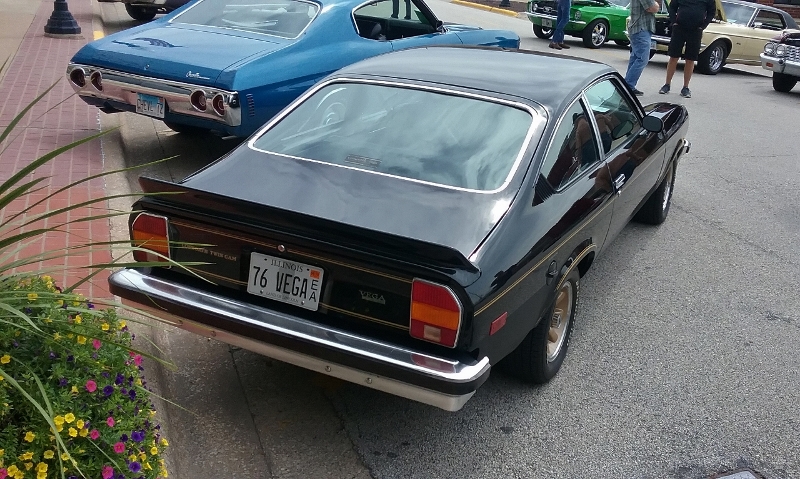
Vega is a four letter word. Literally and figuratively, of course. Why, you’d think only Chevrolet made subcompacts with questionable fit and finish in the 1970s. Um, Datsun B210 Honey Bees, anyone? Rapid-rusting ’74 Corollas? Pardon me while I roll my eyes. OK, where was I? Yes, well, today I’m not going to add more to the blogging cannon fodder directed at the Chevrolet Vega. No, today, I’m here to talk about the good parts, the fun parts. And no Vega was more fun or more interesting than the Cosworth.
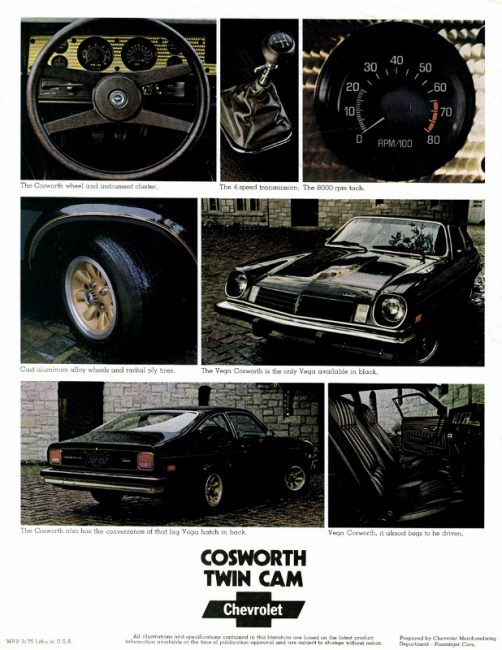
Of course, the Vega story has been told many times before. Introduced in 1971, it lasted to 1977. Early cars had issues. Rust issues, oil starvation and the novel chemically-etched piston sleeves proved problematic, especially the early models, ironically the best looking ones. But they were attractive cars, with their Mini-Me Camaro styling, particularly in the fastback and Kammback station wagon versions.
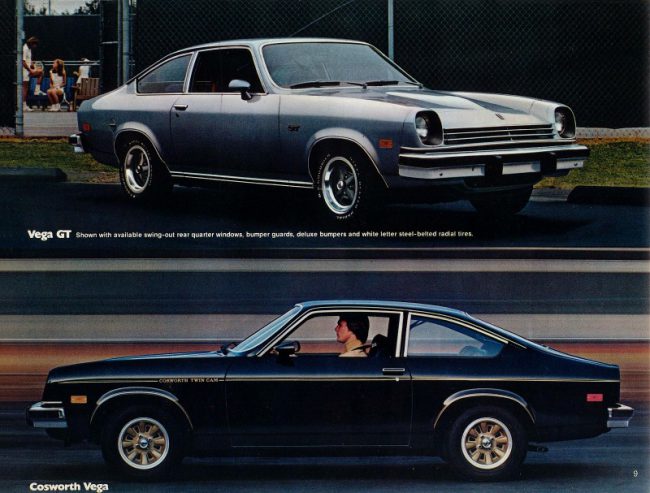
The Cosworth initially was scheduled for introduction in 1974, but many teething issues delayed it to model year 1975. As you’d guess, it had a twin cam head added, developed by Cosworth, with Bendix fuel injection. All ’75s were available in a single color scheme, black with gold pinstriping and gold pseudo-Minilite wheels, with black interior. Only 2,061 were built, most likely due to the $5,916 MSRP. A hefty premium, when a base Vega hatchback started at $2,478. Six grand was Oldsmobile Ninety-Eight territory back then!
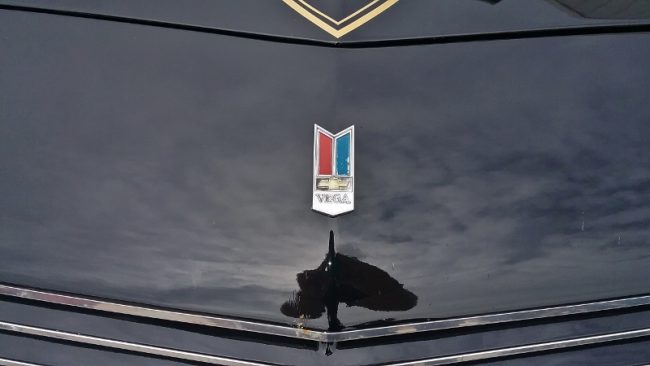
The sporting Vega returned in ’76, now offered in a variety of colors instead of the basic black scheme. Pricing inched up to $6,066; production, 1,447. For that money, you could have gotten a Ninety-Eight Luxury Sedan or Electra. Or Corvette.
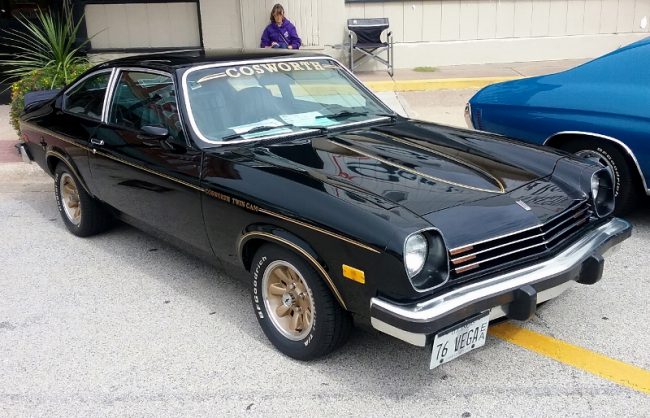
Total Vega production was down to 160,524, not bad, but not as good as earlier years. Cosworth horsepower was about 110, when a plain Jane Vega generated around 75-80. The irony is that by this time many of the kinks of the Vega had been worked out, and it was a pretty decent car now-by 1970s standards. But the Vega-based Monza was more popular with its optional V8 and Italian looks, and other new subcompacts from the competition were proving compelling. And early Vega adopters, having been burned badly, had zero interest.
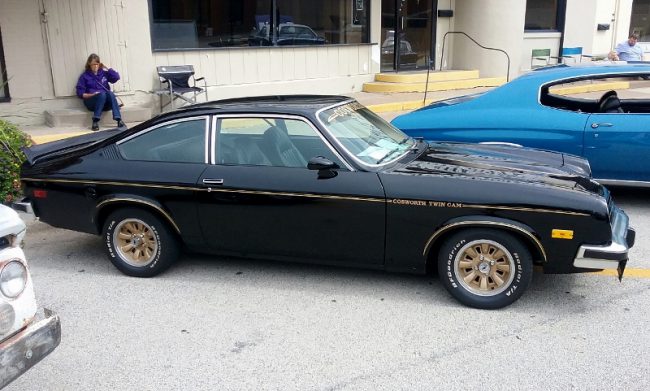
Chevrolet touted the Vega’s solidity in period advertising and in salesroom brochures. A 60,000 mile durability run was done in Death Valley over a 60-day period. Cars used for the test were equipped with the Dura-Build 140 CID engine-the same engine, but updated.
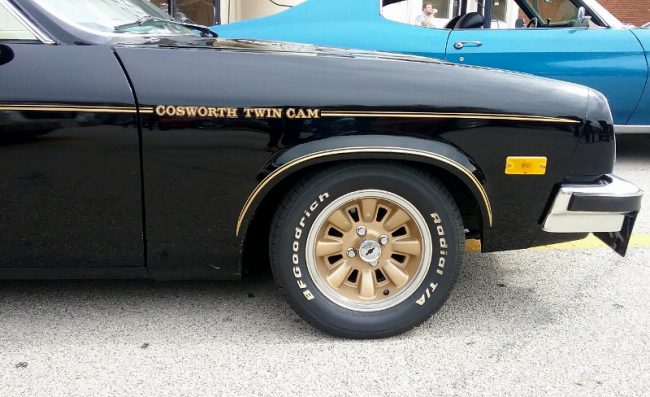
Only 24 ounces of coolant needed to be added to each test car for the duration, and only one timing belt had to be replaced on a single car. Chevrolet added a five-year, 60,000 mile warranty to all 1976 Vegas as well. Separate passages for crankcase ventilation and oil return were added in 1976 too, which prevented oil from collecting around the valve stem seats, an issue on earlier Vegas.
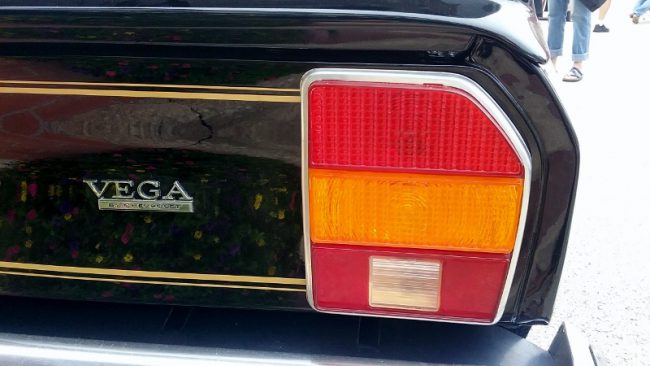
Today’s featured car is owned by Ed Stembridge, who is relatively local to me here in the Land of Lincoln. I’d heard about the car early in 2018, but hadn’t seen the car in person. But in early September, he called and said he was bringing it to the annual classic car show in Galesburg, Illinois. So finally, I got to see it in person! His first car was a bright blue 1971 Vega, which later on he souped up with a Buick V6. He found this car earlier this year. The price wasn’t bad and the car wasn’t too far away, so he drove up to see it. And brought the trailer with, just in case. As it turned out, that was a good idea.
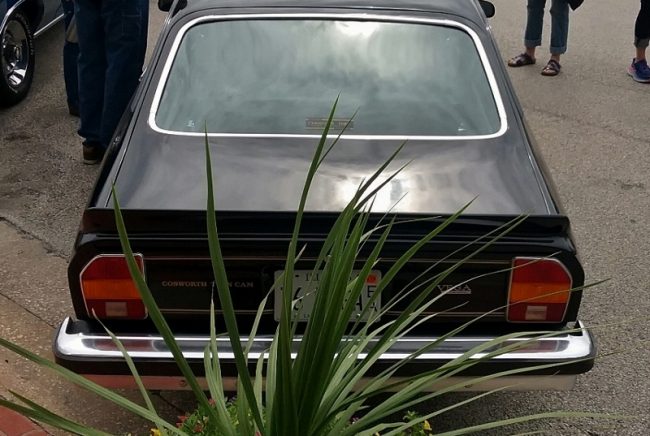
Long story short, he bought it. It ran great, the price was right, and it was in nice shape. It did have a period-correct giant front air dam, which Ed removed. It was just a little too over the top for his taste. The rear spoiler is a similar vintage item, but it looked nice enough, so it stayed on the car.
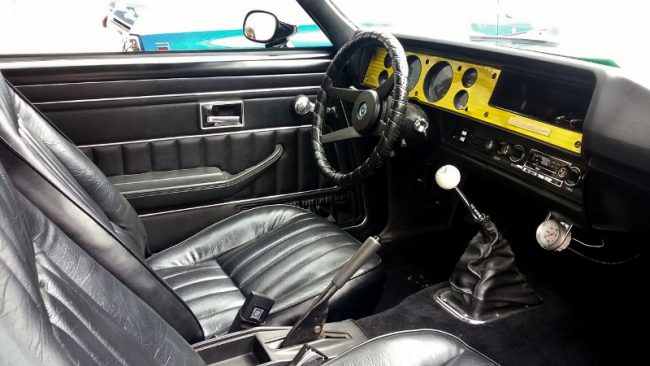
This car was sold new at Sycamore Chevrolet, in Terre Haute, Indiana. The second owner also lived in Terre Haute, and eventually he sold it to owner number three, who eventually relocated to Rockford, Illinois.
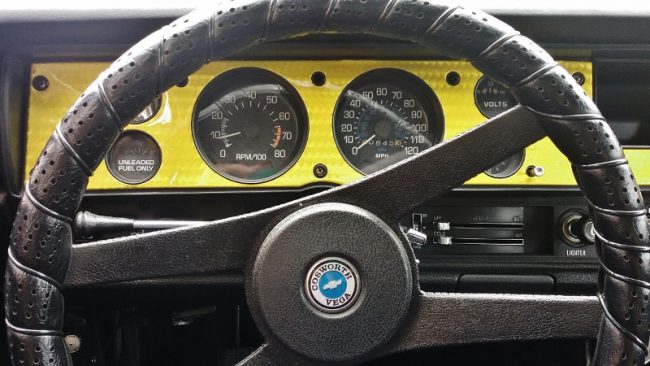
This car was completely restored in 1999, right down to the bare shell. The engine was rebuilt as well. Between 1999 and summer of 2018, an additional 6,000 miles have been added to the clock. Ed’s intent is to bring it back to factory stock-with the exception of the engine and suspension modifications.
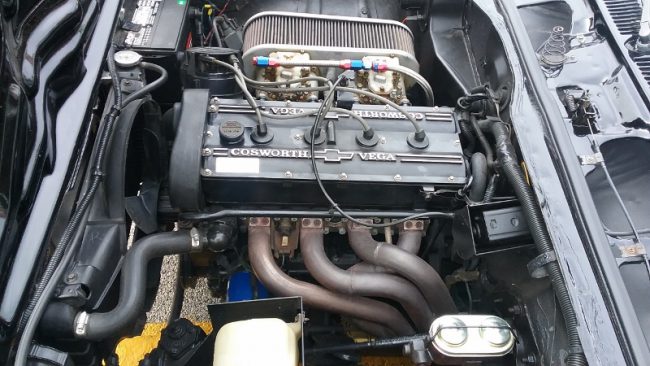
One of the previous owners set up the car for autocrossing, and so the original engine, rated by the factory at 110 hp, now produces between 140 and 150.

Custom features of the engine include:
- Rods polished and ARP bolts
- .030 over 9.5 to 1 forged pistons
- Sleeved block
- Converted to 42 DCOE Webers
- Total Seal rings
- 2 1/4″ exhaust with 2 chamber Flowmasters
- 4:10 posi rear (upgraded from factory 3.73 gearing)
- IECO lowering shocks
- Flaming River quick ratio steering box
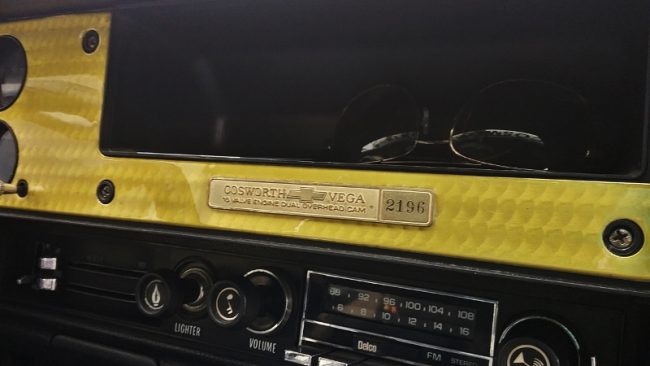
While all inaugural year 1975 Cosworths were black with black interior, 1976 added several interior and exterior color choices. Ed isn’t in a rush to sell off this car, but if a Cosworth in a more interesting color combo appeared, who knows?

I remember seeing a white one with black and white interior in one of my Chevrolet books that was pretty sharp. And a few years ago, there was a low-mile one on eBay in Firethorn Red with white vinyl seats and red dash and carpet. Now that one was nice! But whatever one you get, I can attest that the seats are damn comfortable!
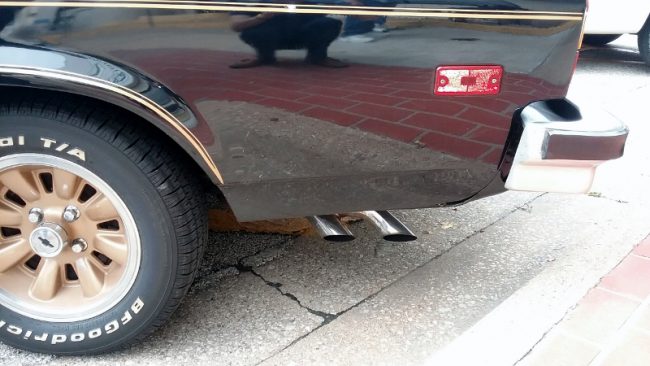
While the Vega line would continue for one last curtain call in 1977, the Cosworth was discontinued. Slightly over 3,500 were built in 1975-76, making them a rare sight at car shows today!

Of course, despite the special engine, trim, paint and other cool additions, it’s still a Vega at heart. So you won’t be seeing Caprice Classic levels of glitz, chrome and velour-clad sumptuousness. But the interior is still pretty nice. Though Ed mentioned the black interior was a little warm on the drive up to the car show with no air conditioning!
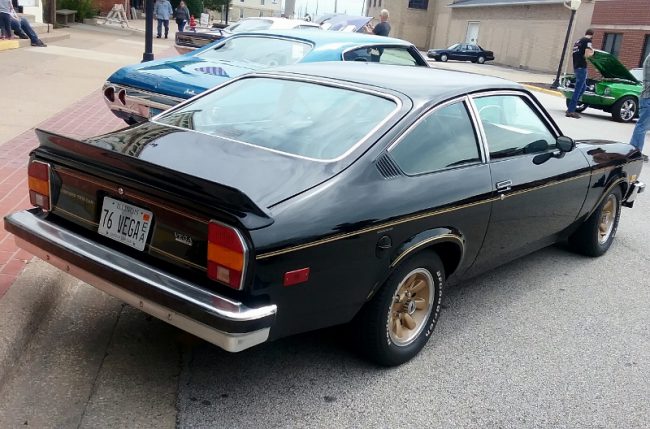
But that’s not the point. The point is it’s a fun, rare old car. Something you don’t see every day, unlike the myriad Resale Red, Foose-wheeled 1967-69 Camaros you see at every car show and cruise night in the summer time. Cars like this are the standouts, the interesting ones that make you step aside and check it out. All that, and a blast to drive, too! That’s the Vega Cosworth.
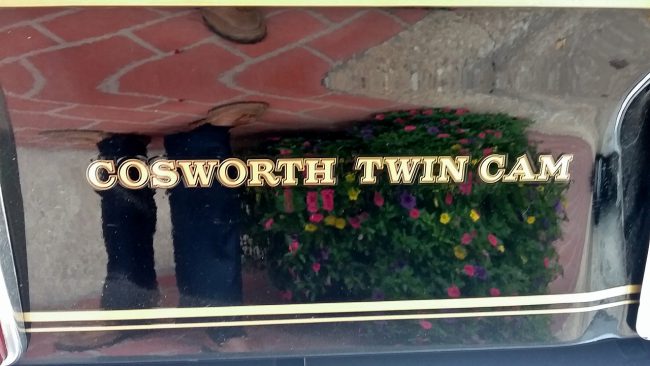







47 Comments
One additional reason for the delay in the Cosworth introduction was trying to make it meet emission standards. As a side “benefit” the horsepower also took a beating. IIRC, Chevrolet was looking for 160-180 BHP from the original design. By the time it was detuned and strangled it was down to 110. Now you had a Vega that was a few hundred dollars below the cost of a Corvette, with 1/2 the horsepower and none of the prestige. Therefore, not surprising production was so limited and only lasted 2 years.
As a side note; there was a local Chevrolet dealer (like others around the country) that was swapping 350 V-8’s into Vega’s. Made for a quite “exciting” ride.
You remembering this from an old GrassRoots Motorsports article about 20 plus years ago?
For a buyer the car made very little sense once it started being sold. The rep of the basic car was already baked in. You would have to be dense not to think that the rusting hulks of Vegas in previous years was going to miraculously be different just because of the engine. And a potential buyer being within spitting distance of a Corvette.
I last saw a Cosworth Vega in Mass., in the winter at a gas station filling up about 6 years ago. Rust holes and covered with State of Mass. salt. Weird. I don’t think I ever saw any Vega for the previous 25 years on the road.
I remember the price stories from when the car was offered for sale. The engine story, not sure where I saw that, but it was sometime in the mid-late 80’s.
Great post, Tom. I was still in middle school when these cars came out; a neighbor had a buddy who bought one and we all glommed around it like it came from another world. It was pretty technologically advanced for small town Ohio in 1975. But, like the one ad famously noted, you could get one Vega for the price of two!
I kind of think of these as the red headed stepchild of the Chevy performance family. You could slap an SS badge on a Radio Flyer wagon (or the Malibu Maxx) and there would be a group formed around it when it shows up to a show. These Vegas show up and outside of folks who are in the know, they seem largely unloved.
Due to our proximity to Lordstown, we saw a lot of Vegas back in the day. If I had the room, I’d go for a nice Vega GT. It would bring back a lot of memories…
It is interesting when Detroit builds something directly aimed at imports. The spec sheet of the Cosworth looks beyond any JDM 76 Celica or 76 Euro GTI, never mind what either manufacturer offered their American customers. Yet instead of praise and God forbid a few sales, we get complaints about cost. As if import buyers mind paying premiums for technology that substitutes for displacement.1.6 liter Accords at Cutlass prices and 1.5 Siroccos at V8 Camaro prices. Here we had a 122 cubic inch four that matched the horsepower of the 265 V8 Monza with all the weight advantages. Maybe the purchase decision was more about politics than actual differences. It wasn’t handling, sporty Vegas were known to handle quite well.
“Maybe the purchase decision was more about politics”
I think a lot of the purchase decision was made on the past reputation of the Vega being a rust bucket, with a lousy engine. In 1972 my uncle bought a new Vega. At 2 years old with about 40K miles, there were rust holes and it was burning a quart of oil every 6-700 miles. He traded it soon after for a VW Beetle, and it was about 25 years before he bought another GM vehicle.
Not that excessive oil consumption was exclusive to Vegas. Had a neighbor that bought a new 1/2 ton Dodge truck with a 318 in 1976. From the day he bought it until he traded it a couple years later, it would use a quart of oil every 1,000 miles or so. He brought it to the dealer to have it looked at and they told him “that’s not excessive”. AFAIK he has not bought a Mopar vehicle since.
Yes a Beetle is a great way to avoid oil issues. I hope so at least since the engine relies on the oil for both lube and cooling. Bet he loved changing the oil every 1500 miles and adjusting the valves every other day. Simple if you just read that hippy’s book on how to keep it going while sticking it to the man. Wolfsburg, I love you so… Lordstown….deplorable losers.
In our extended family, there were at least 6 air cooled VW’s. The oil change frequency was no worse than domestic engines, valve adjustments were infrequent, at around 10K miles IIRC, when there WAS some form of major issue you could have the engine sitting on a bench in about 20 minutes. The biggest issue was they were slower than a bicycle, especially if there were hills.
My parents bought me a 74 Super Beetle for a HS graduation present. I consider it the most well made POS ever made. I think it put out 40 HP. Loved removing the oil plate at the bottom of the engine. That thing was a death trap in the making with cross winds on a highway. I once got blown out of my lane and tapped the front bumper of a pickup next to me. Spending 10 minutes in morning in the winter rowing the gearshift lever enough to change gears while have the clutch all the way in. You knew it was ok when you could let the clutch out in neutral and the engine wouldn’t die.
Despite what some might think, I was never a big fan of VW Beetles. On their best day, they were basic transportation. Like every other vehicle, they had good points (fuel economy), and bad points (everything else). There never has, and never will be, the “perfect” vehicle.
I’ve owned a couple of air-cooled VW buses and even had a subscription to Hot VWs magazine for a while. At the height of the Beetle’s popularity, the mid 1960s, it was already a 30 year old design and very primitive. It still had Dr. Porsche’s trailing arm front suspension using torsion bars, and in the back there were still the swing axles that Porsche borrowed from Josef Ganz’s designs in the 1930s. Unassisted drum brakes at all four corners. It was the opposite of modern automotive design, but Wolfsburg apparently built them very well. They were simple, cheap, and easy to fix. They also competed in a segment that the Big 3 ignored for some time.
Imagine, though, Ford trying to sell the Model A in the late 1950s and early 1960s.
And yes, the early Toyotas and Datsuns here were, by American standards, crap. They had unimaginative RWD engineering, odd styling, second rate automatic transmissions, HVAC not up to the extremes of American temperatures, and bodies that rusted even where they didn’t use salt on winter roads.
1000 miles per quart would have been outstanding for a Vega once 50k miles were past. Mine burned a quart every 75 miles.
The spec sheet of the Cosworth Vega had only interesting equipment to distinguish it. There was no return on the investment in terms of performance once emissions equipment durability standards were met. Fuel injection, twin cams, and 16 valves were all marketable technologies in the ’70s, but the point of having them was supposed to be outstanding performance. Do you think it was treason to buy a three thousand dollar Celica you could afford instead of a six thousand dollar Vega that you couldn’t?
While you’re boohooing about how hard it has been for Detroit to compete with the imports, the Vega is a very real reason why. It burst onto the market and immediately outsold almost every import because buyers wanted Chevrolets more than they wanted Datsuns or Toyotas. In its wake, several hundred thousand Chevrolet customers had their eyes opened to just how badly GM took them for granted.
The Celica of the time had an engine derived from the Chevy 6 that they admittedly much developed. It was then assembled by workers who made less than half what the UAW workers earned. It was then sold with only a token tariff instead of what Japan put on our cars. The treason, your word not mine was not the buyers but the politicians who allowed Toyota into our market to do that to us. So yes, I boohoo how hard it is for GM to compete.
How come GM could build the roadmap for legendary small engines and still not follow it?
While Toyota did make improved versions of Chevy’s Stovebolt 6 from the ’30s into the ’50s, what exactly did they share with the small, four cylinder, overhead cam engines in the Celica?
If I’m Tokyo Rose, you’re Hiroo Onoda; a soldier fighting a war that’s been over for thirty years. GM is a Chinese company whose current small cars are Korean Daewoos made from CKD kits. Did you notice that they’re in the process of using their US workforce as sacrificial pawns in the globalist war on independent nations? These globalists are your guys? FCA is an Italian company incorporated in the Netherlands that sells…pickup trucks that weren’t designed by German, Japanese or Italian car companies. Ford severed its ties with Japan and has gone back to building Eurotrash small cars with Vega half-lives. I guess they’re more American than they’ve been in decades as their sales have collapsed in other markets, but that doesn’t make me want to claim them. They’re getting ready to partner with VW, which is bound to end better for Ford than the Daimler merger of equals did for Chrysler.
The Chevy 6, licensed pre war by Toyopet for army jeeps, was the only engine they knew at the time and when they designed the Toyopet Crown in the 50s that was the basis for the 1.5 four cylinder engine family in it that went on and on, of course not giving credit where credit was do. It was many years and much copying, some licensed, much not before our Japanese friends could come up with anything for themselves. How grateful we should all be for the good fortune of having this ill gotten gain dumped on our car market.
Problem is, even the pricey Cosworth Vega would rust away to nothing in no time at all.
In 1978, I had a 1974 Vega that already had terminal rust all round the windshield and backlight. In Dallas Texas. Where no salt is used on the roads, ever. Believe me, Datsuns and Toyotas of the same vintage, which were notorious as rustbuckets in the North, did not rust in Texas. Vegas did. Something about the design details of the windshield seals trapped water and it could not be avoided.
And of course the guaranteed-to-burn-oil unlined aluminum cylinder block. Mine burned a quart of oil every 75 miles, with only 75,000 miles on the clock. Every 150 or so miles the #3 spark plug would oil-foul and I’d have to leap out by the side of the road, pull the plug, wash it off in some gasoline, and put it back in. The Cosworth used the same block.
I know the (inaccurate) received wisdom these days is that Chevy “fixed the Vega’s problems”, but I was there, and they did not. The last models rusted and burned oil just as enthusiastically as the first. They did not, contrary to current Internet rumors, replace the all-aluminum engine. That was the Pontiac Astre, which is essentially the same body but with the cast iron Pontiac engine instead.
The Vega was about the last nail in the coffin for GM small cars. A shame, really, because the basic car’s design and layout was dead standard and well-proven; it should have been easy as falling off a log to build this car to meet or exceed the standards of quality and reliability of the day. But Ed Cole just could never leave well enough alone and he just had to throw a bad-idea engine into the car along with some bad-idea production process ideas, thus yielding truly one of the worst implementations of a straightforward basic design ever.
75,000 on the Vega doesn’t sound so bad for an economy car. The drive belt would have snapped long before that on the Japanese cars killing their engines. Of course some of the richer owners could have afforded to change out the belt before hand, but the average economy car buyer… not so much. Should have bought the Beetle and the hippy’s book to keep it going on a budget.
“The drive belt would have snapped long before that on the Japanese cars killing their engines.”
No different than the domestic engines when they first started going to OHC. I had mid 80’s Dodge’s where they recommended a 60K miles timing belt replacement. It was however a non interference design, so you would just be dead beside the road, not rebuilding/replacing the engine.
The Vegas 2300 also had a timing belt too, I don’t think the motor would crash though, but it needed to be replaced.
I’ve driven a 76 Astre several times, it was a relatively low mileage 75,000 mile car that had sat in a garage for many years, a clean FL car, no rust. It still had to have the block re-sleeved because the coolant had eaten through the cylinder walls.
They drive like an under powered baby F-body. They are cheap, like cheap to just be cheap. The Astre I drove was a base model, it didn’t have an adjustable passenger seat, not recline, the whole seat didn’t move, it was fixed in one position, it didn’t even had a door jamb switch on the passenger door to activate the one dome lamp.
The Astre I drove was an odd car, power steering, power brake, 85hp 2bbl motor with an oversized TH350 a/c on a base car. It was bought new in Miami. It got about about 75,000 miles put on it between 1976 and 1982 when it was driven by their daughter to college in Louisiana, and according to the original owners my friend bought it from, it was fairly reliable during that time. I drove it once about 40 miles, I couldn’t imagine doing a run from Miami to Louisiana in one.
Overall it was pretty agricultural, it vibrated and trashed, the steering wheel seemed impossibly close to the windshield, the transmission tunnel ate up a lot of interior room and transferred a heat into the black plastic and vinyl interior that was slightly more luxurious than a port-o-let.
I bet the Chevy II didn’t burn a quart of oil every 75 miles at 75,000, on its four cylinder cast iron engine. That was an economy car, too.
IMO, the strategy of the time was to disincentivize buyers drawn to economy cars. The trend was to subcompacts; and the Japanese brands were quickly gaining market share…but the Big Three wanted to prove, that small cars were cheap and shoddy cars. So they gave us the Pinto and Vega…and of course Chrysler ignored the market entirely. AMC just took a sawzall to an existing compact – put it out with no back seat and rubber floor coverings, and called it good. Or good enough. For who it was good enough for.
That was the contempt the American companies had for the buyers of subcompact cars. GM, with its engineering prowess…could have, in those days, put out a rust-resistant, durable subcompact car that would hold up to salt and high mileage.
All that was lacking was the will. The company had changed since the days of the firsts Chevy II; its decision makers had gotten far more cynical.
I always kinda thought that they were so tooled up to make money on the bread and butter cars, like mid size and full size cars that the really didn’t make money on small cars, the H-body probably cost more than an already established car line like and A or B body, especially with all the “new tech” they tried with the Vega. Plus, these were cars that would never ever see the driveway of anyone in management at GM in any way shape or form, so how would they know how it drove or how it was laid out, or with servicing or with any of the issues. Little cars were for poor people, they guys drove company Toronados and Electra 225s to the suburbs filling the tank on the company dime and switching out to new car every 6 months.
NIH really hurt these too, I wonder why they didn’t pair up with Opel for some of the engineering, the Kadette was a well accepted car, not necessarily in the “just rebadge an Opel as Chevy” concept that usually doesn’t work, but an Americanized small car engineered by Opel, built in the US, though that is sort of what happened later with the T-car and the Chevette, and that was ughh…..a little better?
The argument that they should have built a Gremlin type car from the existing Chevy parts bin is interesting but ultimately would have failed as well. Notice Gremlin sales were falling off the same cliff at the time. If it was poor quality that chased of domestic buyers in the late 70s, why did the Chevette sell so well. no.1 in 79. Carmine might be getting at it that the whole small car experiment should be skipped and mass market small imports be kept out by wage equalizing tariffs.
This car is why the Lordstown employees will no longer have a job. Maybe if GM discontinued compact cars back in the 70’s rather than sell Cavaliers and Cobalts at a loss for decades while racking up pension obligations.
I was thinking “Hey, that looks just like Ed’s Vega”
Of course it does, because nearly all the CVs were black & gold. In a stunning reversal the “rare” Vega is now the most common one, because a CV was much more likely to be stored indoors and kept away from moisture than the garden variety.
Plenty of them were preserved as future collectibles for a future that never came. It is possible that many of them were put away by Chevrolet dealers who couldn’t bring themselves to accept whatever loss would have been needed to move them. Whatever the reason was that they were stored instead of used, a pristine early Vega would be much harder to come by than a pristine Cosworth Vega even though more than a hundred times as many were made. Prices bear this out too. A clean Cosworth Vega is about as valuable as a beater Camry, while a clean egg-crate Vega would start a bidding war at any special interest car auction.
The last time a Cosworth Vega was beyond my means was about when I graduated high school. There was one at an auction where everything was mysteriously high. IIRC, it was a retail auction posing as a wholesale auction, and the rubes were getting shucked. The Cosworth Vega was one of two cars that stuck in my memory from that day, the other being an Eldo convertible that was absolutely used up and incomplete but sold for high retail. Come to think of it, maybe I should have been able to afford the Cosworth Vega then too. I figured the high price was because it was still somewhat exotic and mysterious in 1988. Cosworth built winning Indy and F1 engines, and 16 valve, fuel injected GTIs and Toyotas were starting to fill in the ruins of the performance world left by all the terrible turbocharged cars sold during the late seventies and the eighties. The Cosworth Vega still retained a bit of a ‘what if’ aura. Now, 16 valve, fuel injected small cars with well over 110 hp have been used up and recycled by the millions. All of those engines were attached to better cars than Chevy’s Vega. There are still more people giving up on their dreams of returns on storing their Cosworth Vegas than there are people who want to take on a car that was made of the worst stuff GM could get their hands on during the decade that they turned their enviable reputation into an onerous one.
What the Vega was…as that Other Site noted, correctly for a change…what it was was a Deadly Sin.
It was born in the minds of suits higher up – not engineers with a vision. It was engineered OUTSIDE the normal channels, and then forced on Chevrolet. The ultimate horse-designed-by-a-committee.
Every step of the way, design flaws were found in prototype testing; and with every confrontation, the suits at GM Corporate tried to make it a political power-play. Every nickel possible was shaved; every pound that GM Corporate lifers thought was unnecessary, was taken out. And every idea Chevrolet engineers had, such as an aluminum head to go with the aluminum block, got angrily shot down.
So the Vega, a beautiful car, a car with true sporting pretentions…went out into the world with sheet-metal too thin; with a radiator too small; with a heavy iron head on what should have been a light aluminum engine.
It went out with a tendency to axle-hop; it went out with a PowerGlide transmission…singularly unsuited for a small, revving engine.
And EVERY opportunity they had to improve it, address the shortcomings…was pointedly ignored.
What if the Cosworth money had been put into Zincrometal body stock? What if a few bucks had been spent to put in a bigger radiator? What if Chevrolet’s testers had been listened to; and Chevrolet got the Vega right, but a few months later than the Pinto?
Some will say, all cars of that era were lousy. Not so…yes, the standards of the time were lower; but there were imported and some domestic cars that were far superior. I had a 1972 Super Beetle, that, while it was quickly rusting, it remained more solid in use, body and drivetrain, than any Vega. I had several Pintos, and while they rusted, also – and badly, one of them had the left floorboard separate – the body didn’t de-laminate until the final stages. None of them had the huge flat body sections, rust to where they came off.
And a Datsun PL620, a TRUCK no less, was – while obviously light and tinny in the body – was far more solid in construction.
The Vega was its own worst enemy; and Chevrolet’s going ahead with the Cosworth project, long after the car became known as a bad buy…was symbolic of the arrogance and bad decisions.
What if a few bucks had been spent here there and everywhere…. It wouldn’t have mattered a wit. Fender liners were added in 74, fixing the minor compared to Japanese rust. Sales dropped. The engine became dura built, and afterward way outlasted instead of only barely outlasted the Japanese with their built to kill your wallet or your engine drive belts. Sales dropped.
You said in the other thread that big American cars make you puke. Save bet the Vega does as well. You have the right to your opinion and I understand the bizarre looks you would get from your hippy friends proudly showing off anything big three, when all their checks go to Hirohito and alias Willie Brandt. But a tinny, rusty Datsun pickup as a paragon of solidity, you can do better
Japanese cars didn’t rust as badly as the Vega did. There were parts of the Vega body that were bare metal due to large air pockets trapped during the immersion painting process, air pockets that weren’t there to protect the fenders in daily use. The Vegas that sold in the greatest volume also had engines that were incredibly short lived compared to those in any Corollas or Coronas. Lots of Datsuns saw pretty respectable mileages too.
“Fender liners were added in 74, fixing the minor compared to Japanese rust. Sales dropped. The engine became dura built, and afterward way outlasted instead of only barely outlasted the Japanese with their built to kill your wallet or your engine drive belts.”
That’s some Baghdad Bob worthy denial of reality right there. As has been pointed out, the Vega had a belt just like some imports. I don’t think Toyota Corollas had belts in the ’70s, because their volume engines were overhead valve during this period. You think people bought imports because they hate the US, but that wasn’t the case for many people. For every bed-wetting boomer that bought an import because his mom prevented him from ever becoming a man who could look his warrior father in the eye, there were probably three people who got burned by GM, Ford and then Chrysler in turn before trying a Toyota or Honda in frustration only to discover that car ownership doesn’t have to be a hardship.
There are people who complain that one shouldn’t let their memory of getting burned by a string of UAW-3 cars during the ’70s, ’80s ’90s, oughts, early teens, etc… prevent them from buying another one now, when they’ve finally started making cars just as good as the cars that replaced UAW-3 products in their driveways. This ‘reasoning’ falls down on many levels. Learning from experiences is what separates conservatives from liberals. The UAW is a greater threat to my values and freedom than any Japanese, even if most of its members don’t know it. GM, Ford and FCA are just global companies that seek to take as much from the American people as they can while having leverage over our corrupt politicians. Toyota or Honda can shake down a governor for concessions on their best days. GM can dismantle the rule of law. I hope you put it all together some day. Pretending the Vega was a better purchase than a Corolla isn’t much of a start though.
If I am listening to Baghdad Bob, I think you may be listening to Tokyo Rose. “The UAW is a greater threat to my values than any Japanese” . I didn’t know she could still be turned in. It of course doesn’t take into account that Japanese line workers made between 25 and 50 percent of UAW. So UAW made too much, typical greedy Americans. Over time the wealth transfer that apparently you think Japan so richly deserved adjusted the currencies and our relative wealth. It was not only the company towns that paid the price.
You seem to have the idea that the Japanese engines were so great. Well GM can take a bow for that, at least on the Corona/Celica/pickup/Crown/ and more directly the Landcruiser engine that was a Chevy 6 rip off.. Like Nissan can thank BMC for the ripped off A series engine in the 1200/B210. Not sure where Nissan ripped off the OHC inline six(Mercedes?), I will ask an owner next time I see an overheated one.
I suppose the idea that they were lasting 150,000 miles with typical American maintenance was a necessary piece of Tokyo Rose propaganda when memories of the short lives of the last import boom cars were so fresh. Hippies were always willing to believe the worst of their country. They had of course seen all the stand out smart Orientals at their extended college runs. The kids of the UAW, while there blended more, perhaps if they grew their hair?
“Dura built”? What is that supposed to mean?
Listen, I was there. The Vega retained its unsleeved aluminum block and cast iron head, and its propensity to rust away in single digit years in parts of the country where salt is never used, to the end.
Sorry you don’t feel that 75000+ miles in one of Americas least expensive cars was not enough to feel you got your moneys worth. Your 60s equivalent would have been satisfied and just would not have made it in most cheap imports. At what mileage may I ask did you spend up on the belt replacement?
Rust control including Vega got better, not worse over time. Salt on roads and no garage obviously worked against it and hit hardest cheap cars like the Vega.
You don’t know what you are talking about.
1) It is typical for a mid 60s car with cast iron engine block to last more than 100,000 miles before it STARTS burning oil.
2) Tell me all about the vast amounts of salt used on the roads in Dallas, Texas. Oh, wait, I guess you mean the Dallas, Texas that’s located in Minnesota, not the one where I grew up and owned a Chevy Vega.
3) And, no, for a car with 75,000 miles to be terminally rusting (in places where normal cars NEVER rust) and burning a quart of oil every 75 miles, was NOT normal in the 1960s or 70s. Compare the Chevy II; the Falcon; the Valiant; the Ramblers; even the Pinto. All of these were cheap cars.
4) Your argument of the Vega being a “cheap car” and thus whoever bought it deserved what they got is BS considering that the expensive unlined aluminum block OHC engine was a more expensive engine compared to the existing wel proven cast iron engines from Chevrolet and Pontiac. No, that engine technology (which people like Porsche eventually got to work, at much higher cost, and ten years or so later) was chosen because it was a cool new technology and Ed Cole never heard about a new technology that he didn’t force down the throats of the actual practicing engineers, whether it was a good idea or not.
5) Have you ever actually changed out a timing belt on an front engine longitudinal mount rear drive OHC car like the Vega? I have, and it’s less complicated and time consuming than it was to cut apart the silly one-piece air cleaner housing on the Vega so you could replace the $5 element rather than the $30 sealed unit.
The fender liners solved nothing – as other commentators noted. They rusted as badly after as before.
“Durabuilt” was a rebranding – not a redesign. They wore out as fast before as after. Proof of that is that the engine disappeared even before the car did – the Monza wagon WAS the Vega, with a different engine.
Yes, a large, soft-sprung, wallowing car with numb steering does repulse me. I remember the difficulty people had putting those cars in their garages. And I remember how well the downsized 1977 B-body sold…I obviously was not the only one who thought those things were excessive.
Cosworth Vega – a high-tech engine installed in model with a bad reputation for rust and poor engine durability (but great handling) for the price of a Corvette. And for that Corvette price you couldn’t get A/C at a time when virtually all cars in that price range had A/C installed. The problem for the US auto industry at the time was that putting in a small-block V-8 was a much less expensive way to add power than resorting to overhead cams and fuel injection. Except for brief periods during the two 1970s fuel crises, fuel was cheap in the US and so people didn’t mind spending a few bucks extra in fuel to get smooth, low-stressed V-8 power, which is why the Monza V-8 was much more popular than the Cosworth Vega. And of course, GM and Chevy dealers would much rather have you buy a more profitable Camaro or Monte Carlo than a Vega or Monza, so they didn’t put much effort into making the cheap models comfortable and durable, which created opportunities for the Japanese and Europeans who had to deal with high fuel prices at home and hence put more effort into small cars and more technologically advanced small engines.
Given that this was aimed at a different buyer the A/C was not so serious. The imports then were mostly dealer installed kits like this would have. The performance, specs and price were better than say Alfas or the VW Porsches. Yet the import buyers stayed away. As with Ford a decade later when they tried an SVO Mustang aimed at import drivers alongside the cheaper domestic aimed V8 GT. For many import buyers, the act of buying is a way of communicating something about themselves and their generation. The domestics have never fully realized this and so all the import me too cars. As nice as it was, this was the reason of the failure of the first domestic me too, the Corvair
I don’t recall that there ever was a dealer installed A/C option on the Cosworth. The big advantage that the European imports had was much better material quality and fit and finish. The Cosworth was $4,000 engine in a $2,000 car, while a BMW 2002, Porsche 914, Alfa GT had more sophisticated suspensions, stiffer body shells, reclining seats of high quality, etc. that gave a much better driving and visual impression than a fancy Vega, not that they didn’t also have problems with rust or mechanical gremlins. I owned a 2002 for many years and had friends with Vegas and Monzas – and there was no comparison in quality, driving sophistication, MPG. They could at least say their cars were much cheaper to buy, but a Cosworth owner couldn’t.
Just for clarity and autism here… the passenger seat in the 914 not only did not recline, it didnt even slide!
But Jack, you don’t carry passengers in a 914 – don’t you know it was one of those new fangled mid-engined race cars?
I am not sure the development cost was as high for this car as people think. DeLorean had worked with Bendix on the fuel injection as a demonstration of the companies abilities. Given that it wasn’t passing the smog test easily, the demonstration was a failure. Remember that was supposed to be the big draw of FI in the 70s.
Similarly the Cosworth head design. A decade later they did let Cosworth loose on the small block for the King of the Hill Corvette and the big Vauxhall V6. Chrysler also had them do the early 16 valve head on the 2.2 engine as installed on the Chrysler/ Maserati TC. There again, they took forever and most buyers took the cheap and smoky mitsu V6.
” A decade later they did let Cosworth loose on the small block for the King of the Hill Corvette”
And had a similar issue selling them. A quick internet search shows that GM EXPECTED to sell 4000 per year, but only sold less than 7,000 total over it’s production run (1990-1995). I would say there were 2-3 things going against the ZR-1 for sales; First was the Corvette’s recent reputation (mid 70’s on) as a “poser”, i.e., all show, no go. Second would be there was little to distinguish it from a base Corvette to those were not in the know about what the ZR-1 was. At a quick glance the only difference was the tail lights, and 99% of the population wouldn’t even notice that. Third was the price, just shy of double a base Corvette. Many thought that brought the car into Ferrari/Porsche/Lambo, etc territory, WITHOUT the “snob” appeal.
While you might think I’m one of those “hippies” that loves imports you keep referring to, my last non domestic car or truck was a 1972 Triumph Spitfire Mark IV (unfortunately totaled at Road Atlanta’s turn 12 in 1987). Previous to that, there were 3 early 70’s Datsuns 1200’s,1 late 70’s Celica, and a 1980 Porsche 924, all bought used. Other than 3 BMW motorcycles, EVERY car, truck or motorcycle I have bought, has been made by an American based manufacturer since 1984. I don’t have any animosity towards imports, I just prefer domestic iron. However, I will NOT make an excuse for them when they drop the ball. If something is a shitbox, I have no problem calling it one. You previously mentioned how a Chevette was number 1 in sales when introduced. I’m guessing you never drove one. My future ex-wife traded her Beetle in on on in 1980 because it looked “cute”. I drove it a few times before we separated, and found it to be basic transportation at best. Nothing fell off in the 7 months I was around it, but thats about the only good thing I can say about it. It was as slow as the Beetle, and had none of the handling that a then current import had in the same price range.
I of course speak in the general not the individual. People are free to buy what they like. Indeed a car market with 10-20% of the market to allow for all sorts of interesting foreign metal is ideal. I also can understand the young in the 70s being put off by the large American car.
That was what the Vega was for. An OHC engine that worked best with a manual. Relaxed gearing that allowed interstate travel, something barely possible on small imports. Sporty two door styles to not poach more lucrative family cars up the line, but great for young singles including girls who need AT and PS. Indeed early sales were strong. Then suddenly everyone turned on it and it got far more venom than even any big car got. No you can’t inflict this on us. An early Rabbit sure, a CVCC Civic sure. But nothing from Detroit. Pinto and Gremlin also spurned. Politics at work.
Sales for the Vega were strong through its whole run, they made the millionth Vega in 1973 they only started only tapering off after the Monza and Chevette came out, they peaked between 1973-1974 427,000-460,000 being made.
” But nothing from Detroit. Pinto and Gremlin also spurned. Politics at work”
While there was likely SOME politics at work, I remember going to some local tracks that would feature the destruction of some Japanese import car, for most folks it was voting with their wallet. If you could buy an import that would give you 150K relatively trouble free miles (no mean feat in the late 70’s) for similar money, that was where they spent their money. And the Japanese in particular were continually making their products better. Domestics on the other hand seemed to be run more by bean counters than engineers. The Chevette, Ford Festiva and similar cars were a joke. No innovation, just “this should satisfy them” attitude. It was also present in their larger car offerings. Quality seemed to be “Job 3” at best, for most. But there were millions of us who STILL bought domestics. As time went on, the domestics still seemed to be “phoning it in”, so more went to imports.
My dad was a dyed in the wool Chevy man. Pickup’s Monte Carlos, Caprice’s, Astro vans. 7 years ago he went looking and Chevy had nothing that he wanted. No more Astro, no Caprice, so he looked at their small CUV’s. Compared it to a Toyota and ended up in a RAV4. This from someone who owned ONLY Chevys from the early 60’s until then.
Myself, I might buy a new truck next year. My 06 Dodge 3500 diesel is still strong, with just under 100K miles and is still in very good shape. Even tho we lease Fords for our work trucks, I’ll likely go with a new Ram, IF I pull the trigger. I’m just not sure if I want to spend $75K on a truck yet.
No, it wasn’t politics at work. It was burning a quart of oil every 75 miles and great huge rust holes all round the windshield in a four year old car in Texas.
I’d add a 4th to your Corvette ZR1 discussion, by 1992 you could get a 300hp LT1 vs the option of 75-105 more hp for $20,000